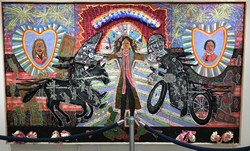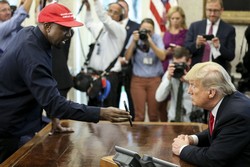Students, Long Branch residents, art enthusiasts, gender equality activists, and the general public alike all gathered at the Pollak Gallery to celebrate the opening of the Beyond #MeToo exhibit on campus last Friday, Feb. 1.
The gallery was opened as an accessible and informative physical manifestation of the issues and concepts encompassed by the #MeToo movement.
The #MeToo movement began in October 2017, after news broke of allegations against movie mogul Harvey Weinstein from dozens of women telling stories of his sexual abuse and harassment in his professional career.
In the wake of these women speaking up against their abuser, other women who had undergone similar abuses in their lives were inspired to do the same and came forward with their stories personally, publicly, and legally.
Yet the movement for gender equality didn’t stop after the public’s fascination with the sexual assault allegations faded, as there were and are still huge strides that need to be made for gender equality.
That’s where the Beyond #MeToo Gallery comes in.
The event was put together in honor of all the progress made towards equality.
From now until April 30, the Pollak Gallery is filled with impactful and powerful works by artists who span a variety of mediums, techniques, and concepts, all interconnected by one common thread: the struggle for gender equality.
When you enter the gallery, you are greeted by three huge canvases with wild colors and lights on them.
The pieces are made up of melted wax used like paint to depict intense portraits of the artist’s interpretation of (as they’re titled), Election 2016, Women’s March, and Me Too.
All three were completed by Julia Dzikiewicz in her studio, which used to be one of the prisons that held arrested suffragettes in 1917.
On her subject matter and works, Dzikiewicz said, “I started painting about the suffragettes, and I researched and read books and went to the national archives in Washington D.C., to inspire more paintings about their struggles.”
Dzikiewicz continued, “And after a while I realized that voting rights were still under attack and that women still had a long way to go to expand their rights and to keep the rights they already have. So then I started painting modern women who are advancing the cause.”
Dzikiewicz then said something a lot of the artists in the gallery may have also felt relating to their subject matter, which was, “I was hoping to end my series with the first woman president. When that didn’t happen, my grief over that loss resulted in the painting Election 2016.”
Dzikiewicz echoed a common theme many of the artists discussed as they spoke about their works.
It seemed like all these artists didn’t necessarily want to be painting about the struggles and history of gender inequality, but had witnessed and lived through so much of it, that they channeled it into art as a form of therapy.
Marie Corfield, a featured artist who created Self Portrait: Enough!, said, “I’m not a full-time professional artist, but at different times in my life, big emotional upheavals would occur and I would just have to lock myself away and create.”
While looking at the pieces and listening to what artists had to say about them, one thing was clear: these pieces are not just trying to progress a movement, but they are the physical manifestation of a cry for change; a beckoning for people to see the work and understand. This message is all over the walls of the gallery.
As Jennifer Reddy said about her piece, Reclining Woman in Protest (which was a textured and earthy ceramic figure of a women lying in the floor with her mouth wide open with the tongue binding the body), “Her mouth is wide open because this is a protest. And despite the fact that she is being bound by her words, which I think women feel, it doesn’t mean she doesn’t have power because she still has her voice.”
The gallery itself was a siren song to bring people together to collectively shed a light on the skewed society in which we are living, with each artist shining a light on how they interpreted different events and repercussions of that which the feminist movement has been fighting against for decades.
PHOTO TAKEN by Kathryn A. Schauer



